CAMBRIDGE, Mass., Jan. 3, 2022 /PRNewswire/ -- Based on an analysis of anonymized energy data in more than 10,000 homes that have the Sense home energy monitor, Sense released today an analysis of 2021 home electricity usage which reveals that many of the trends set in motion by Covid are now persisting into a second year.
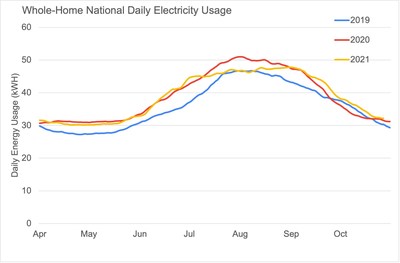
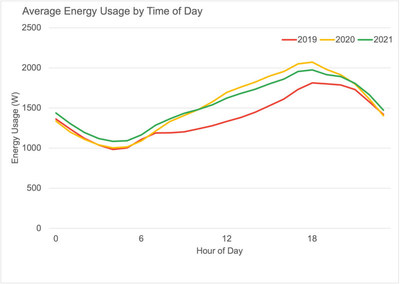
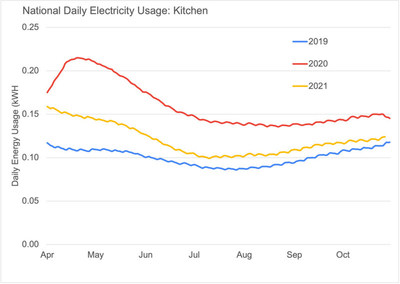
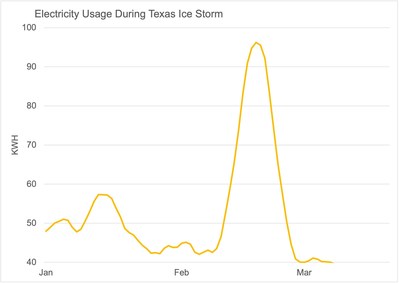
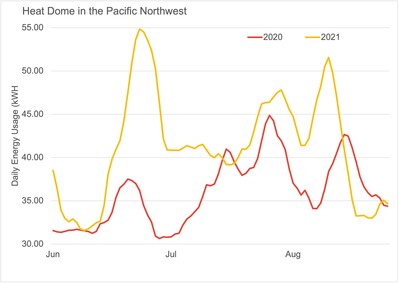
The analysis also showed that extreme weather events driven by climate change have triggered abrupt and extreme peaks in electricity usage that translate into unexpectedly higher utility bills for many people. Assuming that society trends post-Covid and extreme weather continues, this could be the new not-normal.
Some insights from the data from Sense homes:
- Overall, household energy consumption has risen since the start of the pandemic due to a combination of people being home more due to Covid, extreme weather, warmer summers and an ongoing trend toward household electrification.
- In 2020, median household electricity usage rose 8.2% compared to 2019, and it marginally declined in 2021. Between April and October alone, the period of peak electricity usage across the country, the average household paid $55 more in 2020 and again in 2021 than in 2019.
- Many people who stayed home after Covid are still there. Electricity usage between 8 am and 6 pm increased 13.3% in 2020 compared to 2019. In 2021 it declined only slightly (by 1.3%) suggesting that most of the people who began working from home or resigned their jobs after Covid are still at home.
- Covid's impact on energy usage during the day was strongly regional. Changes varied widely, with the biggest increases in daytime energy usage from 2019 to 2021 in the Pacific (17.8%), New England (17.5%) and mid-Atlantic (16.4%) regions. The smallest increases took place in the South (4%) and Southwest (8.7%).
Back to eating out
- More people are cooking at home since the Covid pandemic, but the trend started to reverse in 2021. Average kitchen usage increased by half (50.4%) between 2019 and 2020, and decreased 27.9% between 2020 and 2021. The most popular time to cook? Sunday and Monday, with kitchen appliances getting the least use on Friday and Saturday. The Sense data suggests that most people take a break from cooking on Friday and Saturday and instead they eat out in restaurants or bring take-out home.
While Covid has had lasting impacts, extreme weather has had far bigger effects on energy costs around different regions of the country.
Extreme Weather Hikes Hits Hard Around the Country
Whether it's a heat dome in the typically temperate Northwest or an ice storm in the middle of a mild Texas winter, extreme weather has a big impact on electricity usage. We analyzed Sense data for two of the biggest extreme weather events in 2021 to find out more.
During the Texas ice storm in February 2021, homes that didn't lose power saw a 76.9% increase in average daily usage as compared with the rest of the winter, with a peak increase of 144.9% on February 16th. The spike translated into a 32.5% increase in average daily usage in February 2021 compared to February 2020. At the same time, many Texans were dealing with rises in their electricity rates that led to steep cost increases.
The heat dome that enveloped the Northwest from June to August 2021 led to a 14.5% increase in average daily consumption compared to the same three months in 2020. The sweltering heat translated into a $50 bump in electricity bills in Oregon and Washington, on average.
About the Data Analysis
Sense analyzed anonymized home energy data from 10,000 homes with Sense monitors purchased by customers across the U.S. The analysis of overall national daily usage examined data from April to October for 2019, 2020 and 2021.
About Sense
Sense's mission is to reduce global carbon emissions by making homes smarter and efficient. We empower people to care for their homes and families while contributing to a cleaner, more resilient future. Founded in 2013 by pioneers in speech recognition, Sense uses machine learning technology to provide real-time insights on device behavior, even for those devices that are not "smart." Customers rely on Sense for a wide range of uses including monitoring their home appliances, determining whether they left appliances running and identifying how to reduce their energy costs. Sense has received investments from two of the world's largest energy technology companies, Schneider Electric and Landis + Gyr. Sense is headquartered in Cambridge, Mass. To make sense of your energy, visit: https://sense.com.
CONTACT: [email protected]
SOURCE Sense

WANT YOUR COMPANY'S NEWS FEATURED ON PRNEWSWIRE.COM?
Newsrooms &
Influencers
Digital Media
Outlets
Journalists
Opted In





Share this article